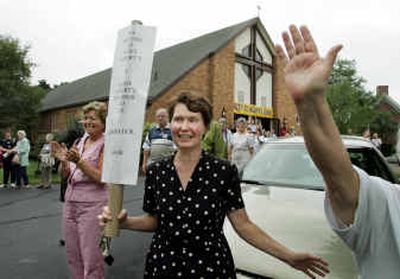Parishioners not ready for church to be shuttered

WEYMOUTH, Mass. – For a church that was supposed to close its doors forever last week, St. Albert the Great parish was a hub of activity Thursday, as members of the congregation lingered after morning services, drinking coffee in a downstairs reception hall or chatting in pews.
For 11 days, parishioners have conducted an around-the-clock prayer vigil – volunteering for shifts and sleeping in pews – that has prevented church officials from shuttering the building. The number of participants has ranged from a few to as many as several dozen.
St. Albert the Great, established in 1950, is one of 18 Boston area churches that had been designated for closure as of Sept. 1. A reconfiguration announced by the city’s Catholic archdiocese last year will close 82 of 357 parishes by December.
But parishioners have sued to keep the church open, saying they own the property, with the archdiocese “serving merely as a trustee.” They have also appealed to the Vatican.
“We have the commitment of the young and the old, mornings, evenings and weekends, because everybody believes so strongly this is an injustice,” said Mary Akoury, 67, who helped organize the vigil. She is one of the plaintiffs in the case heard Wednesday in a Boston court. “They are destroying a very vibrant parish, and we can’t get a suitable explanation for it.”
Church officials point to dwindling finances, shifting demographics, a shortage of priests and declining attendance at Mass to justify parish closings. But worshippers here say that those criteria do not apply to St. Albert the Great. In the past couple of years, the church has erased tens of thousands of dollars in debt and doubled Mass attendance to 1,300 people per week.
The parish was selected to close because the community could no longer support five Roman Catholic churches in close proximity and because it did not have a school or other facilities attached to it, said the Rev. Christopher Coyne, a spokesman for the Boston Archdiocese.
“We’d like people to see there are legitimate reasons why this has to happen. We don’t want it to escalate. Christians don’t throw other Christians out of church,” said Coyne, who said Archbishop Sean O’Malley hoped to avoid a confrontation with parishioners.
But Coyne said that church leaders cannot accommodate St. Albert the Great’s parishioners. “If we made some kind of compromise it would be read by parishioners elsewhere as, all you need to do is occupy the church and they’ll give in,” he said.
The closings have been unsettling for many Catholics in a region still reeling from the clergy abuse scandal that began here more than two years ago, though archdiocesan officials say that the need for a reconfiguration is unrelated.
At least a dozen parishes marked for closure are fighting back, employing a range of strategies. In part because of the publicity it has generated, the sleep-in at St. Albert the Great has become a symbol of the resistance.
Inside the church, there are few signs that something is amiss. Tissue boxes still sit in each row of pews, a remnant of the last official Mass on Aug. 29, when many parishioners said they and their pastor, the Rev. Ronald Coyne (not related to the archdiocesan spokesman), left the church in tears.
A poster lists media outlets for parishioners to call if church officials come to change the locks.
Coyne, who has not returned to the church since Sept. 1, said in a telephone interview that he is not sure St. Albert the Great can be saved but that he is proud of his congregation.
“Even if this does not make a difference for this church this year, it will make a difference for the next generation of Catholics, because they have gotten so animated about their faith,” he said.
Organizers posted signup sheets for evenings through Sunday on a glass wall at the back of the wood-paneled sanctuary, next to news articles about the vigil and messages of support, one of which reads, “No criteria, No closing.”
“The hardest thing about staying here is not getting any sleep. It is pretty uncomfortable sleeping on the wood, to tell you the truth,” said Evelyn Morton, 78, who has spent nine of the past 11 nights in the pews.
Several people left scraps of paper with their contact information in case numbers dwindle.
Lay members lead at least three daily prayer services.
“I’ll do it as long as people are here,” said Pelly Tulimieri, 84, who has been a parishioner for 40 years.
Asked how long the vigil might last, Akoury brings up the story of St. Joseph’s Church in Worcester, Mass., which was marked for closure in 1992 and reopened in 1996 after a lengthy battle that included a year-long vigil by parishioners.
“I’m hoping we can get this taken care of more quickly,” she said.